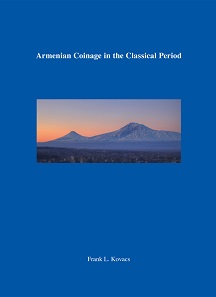August 4, 2016 – Classical Numismatic Group, Inc. of Lancaster, Pennsylvania, and London, England have published the latest volume in their Classical Numismatic Studies series, Armenian Coinage in the Classical Period by Frank L. Kovacs of Corte Madera, California.
Frank L.Kovacs, Armenian Coinage in the Classical Period (Classical Numismatic Studies No. 10). Classical Numismatic Group, Lancaster, PA / London, 2016. Hardbound with dust jacket. 142 pp., 34 plates of photographed coins. US$85.
The need for a revised and updated reference for Armenian coins of the classical period has been evident for many years. Publication has lagged, and with it, the discovery of numerous previously unknown coins while long-standing misattributions have hampered the best efforts of researchers in the field of Armenian numismatics. Armenian Coinage in the Classical Period attempts to address these problems and to present the ancient coins of Armenia as reliable source documents.
Building on the earlier work of Armenian numismatists Bedoukian, Nercessian, and Mousheghian and Depeyrot, Armenian Coinage in the Classical Period begins with the earliest known issues of Samos, after circa 275 BC, through the reign of Tiridates II, to circa AD 252, and includes all territories ruled by Armenian monarchs, or by any king or client king who ruled any territory called “Armenia.” Armenian coins issued under Seleucid, Parthian, or Roman domination are listed, as well as contemporaneous pseudo-autonomous issues. This latter category needs much additional study and the few entries herein make no pretense to completeness.
Although conquered and briefly held by Tigranes the Great, the coinage of the Kingdom of Cappadocia is not included here. Its coins have been extensively discussed and catalogued most recently by A. Simonetta (CCKR). On several occasions Cappadocian kings controlled parts of Armenia; these incidents are mentioned in the text, and examples of their Cappadocian coins are provided in Appendix B.
The specific improvements to the corpus offered in Armenian Coinage in the Classical Period include the attribution or re-attribution of coins to kings and queens to whom no coins were previously assigned, the identification of new dating eras, the identification of new mints, and the removal of non-Armenian coins, fakes, and fantasies from the corpus. While some re-attributions and identifications are conjectural, and will, no doubt, be modified as newly discovered examples dictate, it is hoped that Armenian Coinage in the Classical Period will represent a substantial advance in presenting the basic, original source documents of an important eastern kingdom of the classical period, and will allow historians to better reconstruct the historical record.
Armenian Coinage in the Classical Period will also be available at the bourse table of numismatic bookseller Charles Davis at the annual convention of the American Numismatic Association, held this year from August 9-13 at the Anaheim Convention Center, Anaheim, California.
The Armenian Numismatic Society will also be conducting a meeting at the annual ANA convention where noted Armenian numismatic scholar Y.T. Nercessian will be honored, and Frank Kovacs’ new book will have its formal debut. The Armenian Numismatic Society meeting will be held on Thursday, August 11, 2016, in the Capistra AB Room of the Anaheim Convention Center from 1-4 pm. Mr. Nercessian will be recognized with the first ever Lifetime Achievement Award bestowed by the Armenian Numismatic Society. In addition, a dinner will be held later that evening in honor of Mr. Nercessian. To RSVP for the dinner, or to leave a congratulatory message for Y.T. Nercessian, please visit the website of the Armenian Numismatic and Antiquities Society.
You can find the book on the CNG website.





